Our visit to the village.
Tammy gave us a choice of several outings from Tsevie. We could have gone to a touristy spot to see waterfalls, and I think there was a place to see wild monkeys, but those both required longish tro-tro rides. So, we chose instead to visit a local village, just a couple miles away.
As a PC volunteer, Tammy works with the women in several villages to help build their pottery businesses into profitable enterprises. She has taken groups of these women to Ghana to learn pottery techniques. She also teaches them better business practices, such as how to keep track of costs and income. She is encouraging the village women to increase their efficiency by renting a cart to carry the pots to market in one trip instead of taking several trips, carrying them on their heads.
On Thursday, Tammy's friend came with us on the excursion to the village. She served as an interpreter, since not all the villagers speak French. We took a taxi to the village, although Tammy usually rides her bike. (The PC provides her with a bike, bike helmet, and a motorcycle helmet, since she is allowed to ride on motos in Tsevie.) The taxi's windshield was a mess of cracks.
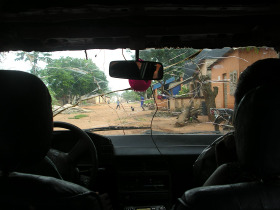
taxi
From the taxi, we saw women carrying large loads of pots on their heads, on their way to Tsevie. We stopped and Tammy said hi.
We arrived at the village and were greeted by the pottery women. They brought out benches for us to sit on, we made introductions, and Tammy gave them gifts (mostly candy). One woman (sorry, I was unable to get the names!) stood out. She was tall and seemed quite smart and capable and was wearing an attractive red and black top. She took charge and led us through the village and demonstrated how the pots were made.
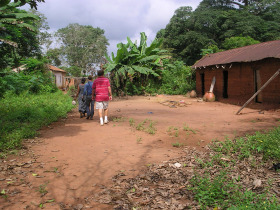
Tammy, her friend, and John walking through the village.
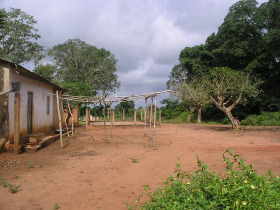
at the village
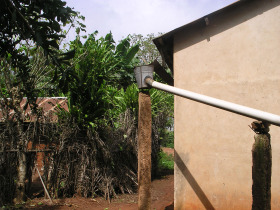
at the village
(This blog entry has lots of photos and more commentary - click on "read more".)
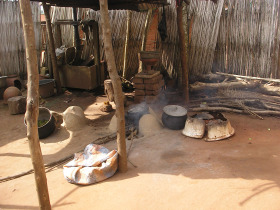
fires that serve as kilns for the pots
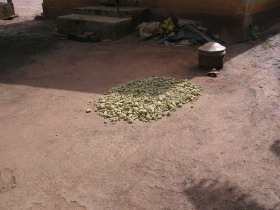
raw clay; I was interested in where they got the clay for the pots
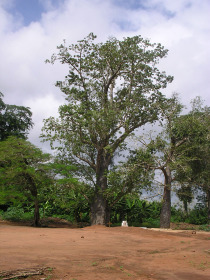
a big, pretty tree
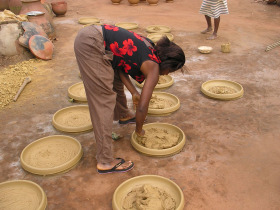
beginning to make a pot
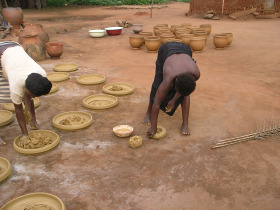
beginning to make a pot - note the woman on the right, she was dressed in a big piece of cloth that was just wrapped around her
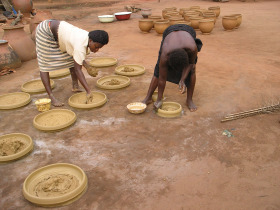
making pots
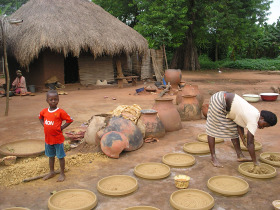
making pots
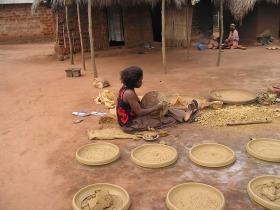
making pots - the woman in the background is putting a coating and design on them
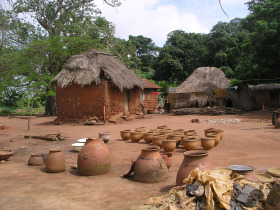
pots
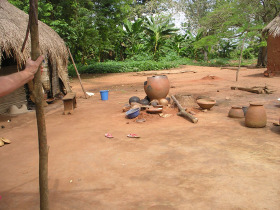
firing pots
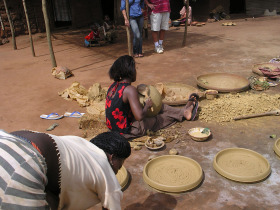
making pots
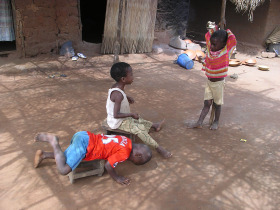
cute kids playing
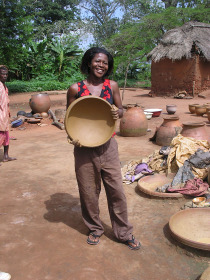
our leader village woman with a pot
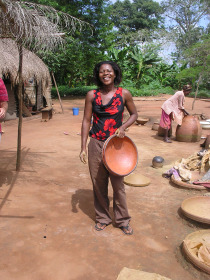
our leader village woman with a pot
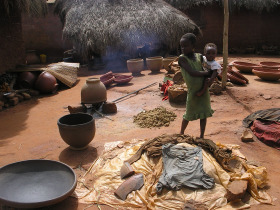
at the village
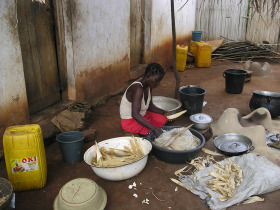
at the village
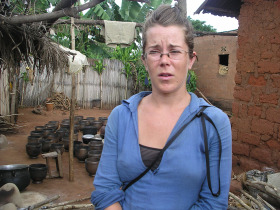
Tammy at the village
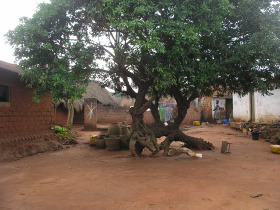
a really cool tree at the village
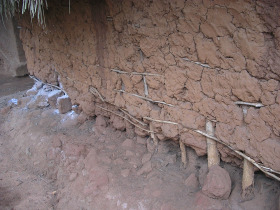
detail of one of the structures
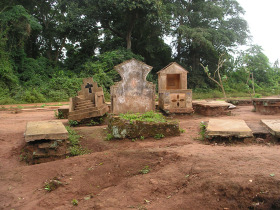
the village cemetery
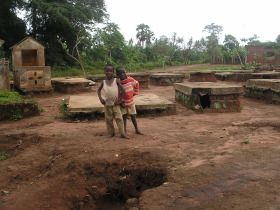
two cute little boys
After touring the village itself, the woman in the black and red top started walking out of the village. We didn't know what to expect, since we couldn't understand what anyone was saying, but we were told to follow. The woman in charge picked up a machete, and in single file we followed her out from the village, across the road, and then into the countryside. John and I expected just a short walk.
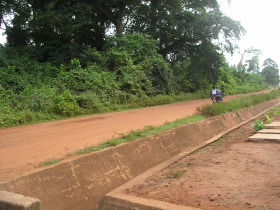
The road we cross to venture into the outlying area - this shows the type of vegetation in the areas outside the city - dense undergrowth, large bushes, large trees.
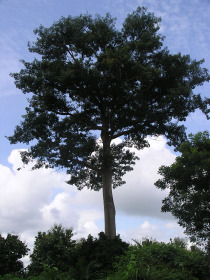
a large and pretty tree
We walked on a narrow path through the dense vegetation. Sometimes lines of poisonous ants crossed our path.
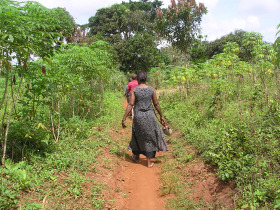
the start of the path we took
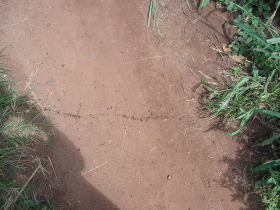
ants
We kept walking along the path.
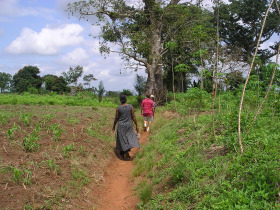
walking along the path
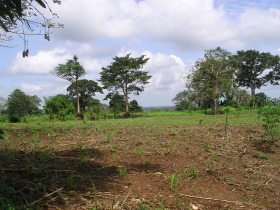
the view from the path
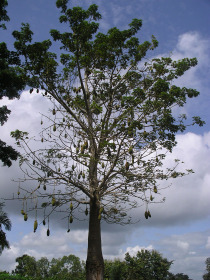
the view from the path
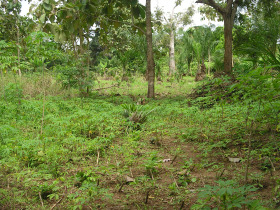
the view from the path
Eventually we came to a palm tree, laid on it's side. In the photo you can just make out a bottle connected to the palm tree. The bottle is collecting oil from the tree.
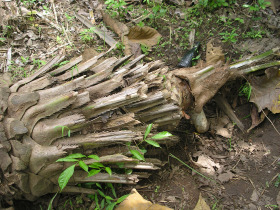
collecting palm oil
We kept walking. "How far are we going?" John and I wondered, silently. It's hot, and I'm glad I'd worn my good walking shoes.
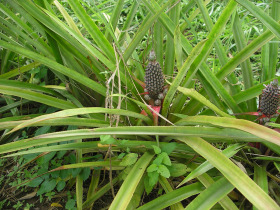
pineapple
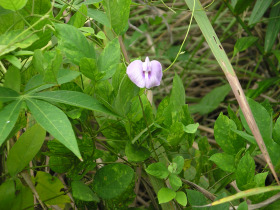
flower
We eventually realize that we are walking through the fields that belong to the villagers. I'm not sure if these are actively farmed, or simply harvested as the natural plants yield fruits.
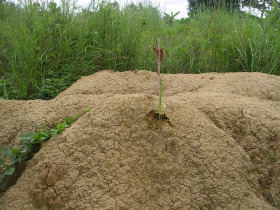
I'd asked where the clay was mined, and our leader pointed out this spot. Each family has a different "plot" for clay.
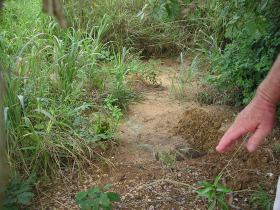
another plot for clay
Our leader stops and goes off the path, and comes back with a bunch of bananas. John volunteers to carry them. Another time, she stopped to use the machete to get a pineapple, and another time, she harvested a yam.
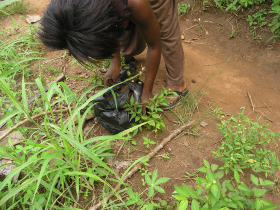
Our leader stops and goes off into the jungle. She comes back carrying a big yam root that she puts in a black plastic bag (a "sachet").
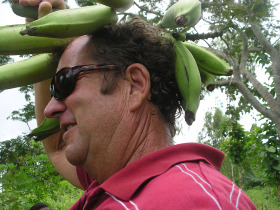
John and the bananas.
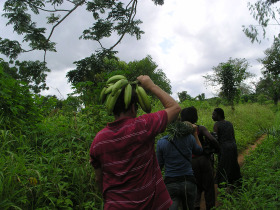
Our little group, carrying the harvest.
Our leader says we are going to the place where the village sotobe is made (we learn this through gestures and translations by Tammy).
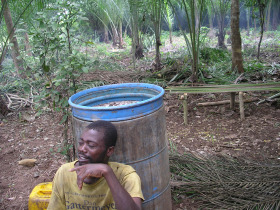
This is the large drum where the palm oil is mixed and allowed to ferment. The top is crusted with debris and bugs.
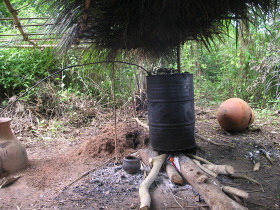
The fermented palm oil becomes palm wine, which is distilled to make sotobe. Here is where it is boiled, and the tubing coming out of the barrel goes to the next container, a big pot.
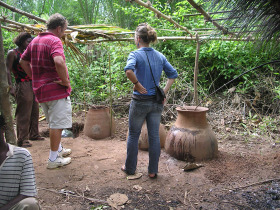
The distillate is siphoned through two more big pots.
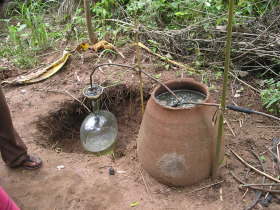
The distillate from the final pot is siphoned into a clear glass container.
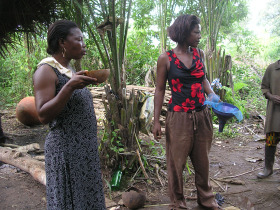
Tammy's friend drinking the palm wine, and the leader holding a funnel and strainer that gets the debries out of the fresh palm wine.
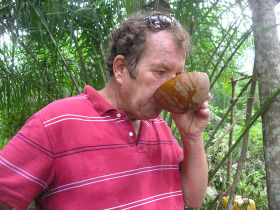
John trying the fresh palm wine - he said it's a lot better than the palm wine we had bought outside the national park in Ghana.
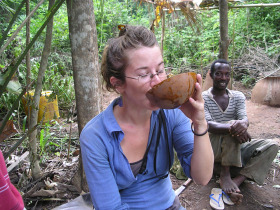
Tammy trying the fresh palm wine - I'm not about to try it, my tummy's still iffy.
We leave the sotobe still and begin our walk back to the village.
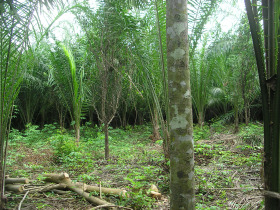
along the path back to the village
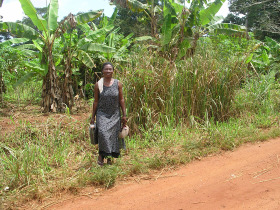
Tammy's friend with a container of sotobe
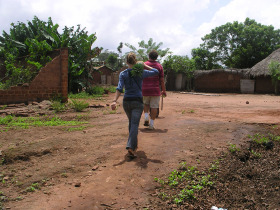
John and Tammy - Tammy is carrying a pineapple that our leader harvested
Back at the village, we say our good-byes and go to the taxi. The villagers gave us the pineapple, bananas, and sotobe to take with us.
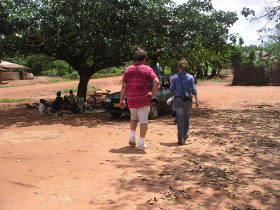
back to the taxi
All in all, it was a long and very interesting tour. We saw how pretty the Togo countryside can be. There were lots of big trees and lots of pretty green plants. I found the village a cleaner and nicer place than the city. Our adventure into the village and the village farms was so interesting that it could be made into an ecotour.
Next: Our last night in Togo.
As a PC volunteer, Tammy works with the women in several villages to help build their pottery businesses into profitable enterprises. She has taken groups of these women to Ghana to learn pottery techniques. She also teaches them better business practices, such as how to keep track of costs and income. She is encouraging the village women to increase their efficiency by renting a cart to carry the pots to market in one trip instead of taking several trips, carrying them on their heads.
On Thursday, Tammy's friend came with us on the excursion to the village. She served as an interpreter, since not all the villagers speak French. We took a taxi to the village, although Tammy usually rides her bike. (The PC provides her with a bike, bike helmet, and a motorcycle helmet, since she is allowed to ride on motos in Tsevie.) The taxi's windshield was a mess of cracks.

taxi
From the taxi, we saw women carrying large loads of pots on their heads, on their way to Tsevie. We stopped and Tammy said hi.
We arrived at the village and were greeted by the pottery women. They brought out benches for us to sit on, we made introductions, and Tammy gave them gifts (mostly candy). One woman (sorry, I was unable to get the names!) stood out. She was tall and seemed quite smart and capable and was wearing an attractive red and black top. She took charge and led us through the village and demonstrated how the pots were made.

Tammy, her friend, and John walking through the village.

at the village

at the village
(This blog entry has lots of photos and more commentary - click on "read more".)

fires that serve as kilns for the pots

raw clay; I was interested in where they got the clay for the pots

a big, pretty tree

beginning to make a pot

beginning to make a pot - note the woman on the right, she was dressed in a big piece of cloth that was just wrapped around her

making pots

making pots

making pots - the woman in the background is putting a coating and design on them

pots

firing pots

making pots

cute kids playing

our leader village woman with a pot

our leader village woman with a pot

at the village

at the village

Tammy at the village

a really cool tree at the village

detail of one of the structures

the village cemetery

two cute little boys
After touring the village itself, the woman in the black and red top started walking out of the village. We didn't know what to expect, since we couldn't understand what anyone was saying, but we were told to follow. The woman in charge picked up a machete, and in single file we followed her out from the village, across the road, and then into the countryside. John and I expected just a short walk.

The road we cross to venture into the outlying area - this shows the type of vegetation in the areas outside the city - dense undergrowth, large bushes, large trees.

a large and pretty tree
We walked on a narrow path through the dense vegetation. Sometimes lines of poisonous ants crossed our path.

the start of the path we took

ants
We kept walking along the path.

walking along the path

the view from the path

the view from the path

the view from the path
Eventually we came to a palm tree, laid on it's side. In the photo you can just make out a bottle connected to the palm tree. The bottle is collecting oil from the tree.

collecting palm oil
We kept walking. "How far are we going?" John and I wondered, silently. It's hot, and I'm glad I'd worn my good walking shoes.

pineapple

flower
We eventually realize that we are walking through the fields that belong to the villagers. I'm not sure if these are actively farmed, or simply harvested as the natural plants yield fruits.

I'd asked where the clay was mined, and our leader pointed out this spot. Each family has a different "plot" for clay.

another plot for clay
Our leader stops and goes off the path, and comes back with a bunch of bananas. John volunteers to carry them. Another time, she stopped to use the machete to get a pineapple, and another time, she harvested a yam.

Our leader stops and goes off into the jungle. She comes back carrying a big yam root that she puts in a black plastic bag (a "sachet").

John and the bananas.

Our little group, carrying the harvest.
Our leader says we are going to the place where the village sotobe is made (we learn this through gestures and translations by Tammy).

This is the large drum where the palm oil is mixed and allowed to ferment. The top is crusted with debris and bugs.

The fermented palm oil becomes palm wine, which is distilled to make sotobe. Here is where it is boiled, and the tubing coming out of the barrel goes to the next container, a big pot.

The distillate is siphoned through two more big pots.

The distillate from the final pot is siphoned into a clear glass container.

Tammy's friend drinking the palm wine, and the leader holding a funnel and strainer that gets the debries out of the fresh palm wine.

John trying the fresh palm wine - he said it's a lot better than the palm wine we had bought outside the national park in Ghana.

Tammy trying the fresh palm wine - I'm not about to try it, my tummy's still iffy.
We leave the sotobe still and begin our walk back to the village.

along the path back to the village

Tammy's friend with a container of sotobe

John and Tammy - Tammy is carrying a pineapple that our leader harvested
Back at the village, we say our good-byes and go to the taxi. The villagers gave us the pineapple, bananas, and sotobe to take with us.

back to the taxi
All in all, it was a long and very interesting tour. We saw how pretty the Togo countryside can be. There were lots of big trees and lots of pretty green plants. I found the village a cleaner and nicer place than the city. Our adventure into the village and the village farms was so interesting that it could be made into an ecotour.
Next: Our last night in Togo.
Comments
No comments yet
Add Comment